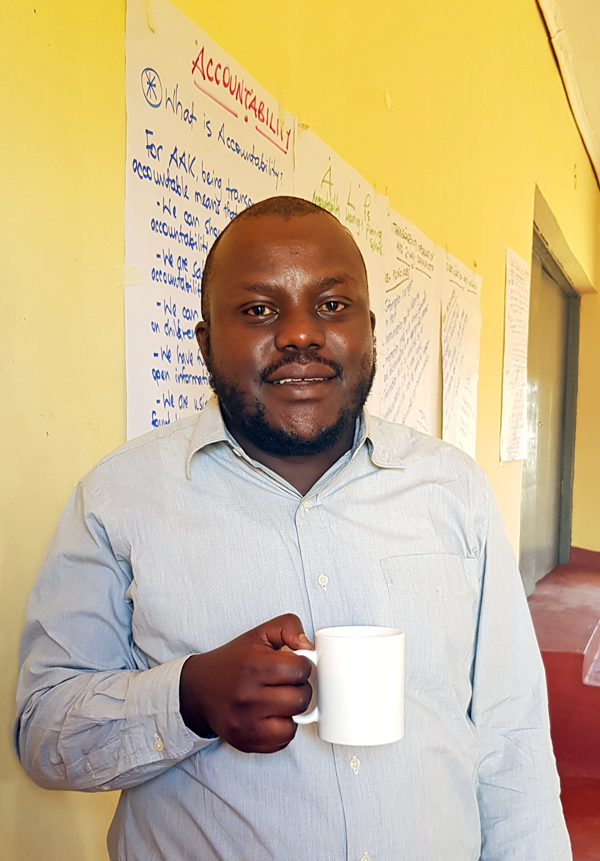“Affected Communities Are the Ones Who Truly Understand Their Own Needs” – Coffee with Denis Orioki, ActionAid International Kenya’s Capacity Building Coordinator
Denis Orioki has been working for Action Aid International Kenya since 2012. Currently, he supports five Local Rights Programmes (LRPs) in Khwisero as a Capacity Building Coordinator responsible for livelihoods and resilience. He has a background in disaster management and international diplomacy, and is currently studying towards a Master’s degree in climate change.

Tell us a little bit about your work, what is your role at Action Aid International Kenya?
I am based in Khwisero, within the Partnership Support Unit. My role is to support five Local Rights Programmes (LRP), which are areas where Action Aid International Kenya has a physical presence within the Western Region of Kenya. Primarily, I work with local partners, especially on issues around livelihoods, resilience and humanitarian assistance; therefore, I am directly engaged with communities and other local organisations. In addition, I help to facilitate interaction and cooperation amongst ommunities, organisations and governmental institutes working on the same thematic areas. I specialise in building the livelihoods and resilience of communities in the face of disasters caused by drought, floods and conflicts.
What is Action Aid International Kenya’s approach to quality and accountability?
In terms of quality, we believe that communities affected by crisis are the ones who truly understand their own needs. Therefore, it is important to work and involve them from the earliest stages of programming, namely when programmes are designed. Furthermore, we make sure that the communities are trained on various standards, for example on the Core Humanitarian Standard on Quality and Accountability (CHS). This is key to make them aware of what to expect from the organisations with which they engage.
How does such a training take place and who can participate?
The community identifies who will attend the training. For example, in Kongelai, where we hosted a CHS training session, we advertised it through the community Baraza, a meeting where community members come together in villages to deliberate on issues which affect them. Through the Barazas, the villages were asked to nominate candidates who were the best‐placed to participate in this training session. Usually, there is a communally agreed evaluation criterion to select participants.
At the training, we share a simplified version of the CHS, and we discuss what the Nine Commitments mean for them and how it would translate into their local language or dialect. This helps community members get ownership of the Standard. After the training session they share their learning with the wider community and disseminate the simplified version of the CHS. This is how communities become aware and empowered to challenge us when we are not in line with the Standard. At our training sessions, we also teach our participants to hold other humanitarian stakeholders accountable too.
How has the CHS made a difference in you work?
In 2016, we carried out a CHS Self‐Assessment, which showed our strengths and weaknesses. As a result, we were able to further improve some of our processes. For example, we have now introduced community-led mechanisms that enable people affected by crisis to participate in the full programming cycle – in the planning, delivery and evaluation phases -, to monitor the implementation, and to give proper feedback on how we are doing.
Let me give two examples. During the CHS Self‐Assessment processes we realised that we are not especially strong on documentation and learning. As a consequence, now we are paying particular attention to having the capacity and the correct processes to properly document our activities. Documentation is key to learning so we can improve our future programmes. The CHS also helped us to make progress on our complaints and feedback mechanisms. Previously it was just an abstract concept, we didn’t have strong procedures for feedback.
What feedback mechanism do you have in place now?
We directly work with communities to develop their own feedback mechanisms. For example, the communities form a body that is called the ‘vigilance committee’. Every village within the Local Rights Programme delegates a representative to this committee. If there is a complaint, it is communicated through the representative and discussed and acted upon at the committee level with Action Aid and other partners. Once the complaint is addressed, the representative of the village provides feedback. They actually hold a meeting to explain the decision and the actions taken.
An important tool of this process is what we call the ‘transparency board’, which acts as a point of information for communities. For instance, the decisions of the vigilance committee are displayed on this board, along with the minutes of the meetings, to ensure full transparency. These boards also display information about how organisations spend their budgets, so that communities can monitor whether the allocated budget was spent in the best possible way.
Do you face any challenges in your work?
Generally speaking, I see accountability as an on-going challenge, as most stakeholders in our sector still tend to think of it mainly as a ticking-the-box exercise. I think it should be an integral part of programming, right from the design phase, and embraced by all of us.
The other challenge is the scale of responses. The number of people affected by crises goes beyond our capacities. This can be overcome by better coordination and collaboration between the government and non‐state actors, so they complement their strengths and weaknesses.
What is your personal motivation to further drive quality and accountability?
I am responding in the words of Chepochemurku, a female community member in Tangulbei, who told me that for us quality and accountability might be something that is part of our work, but for her, it is the hope that she will be able to see a better tomorrow through a delivery of programmes, which optimally address her needs.
